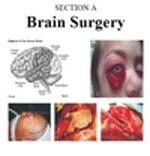Multidisciplinary Approach for the Management of Brain Arteriovenous Malformations
Keywords:
Arteriovenous malformation, Embolization of AVM, Radiosurgery of AVM, Microsurgical resection of AVMAbstract
Objective: The main Objective of this study was to evaluate the significance of multimodality treatment of AVMs.
Material and Methods: The data for this study was collected from the four years audit of surgical management of Arterio-venous Malformation in King Faisal Specialist Hospital and research center Jeddah, from year 2014 to 2017 which include 24 patients with brain AVMs.
Results: In our study equal no. of male and female patients were recorded i.e. 12 patients in each group (50.00%). Seventeen (70.83%) patients were found in the first three decades of life indicating that the disease affects the younger age group. Main presenting complaint was seizures that was noted in 16 patient (66.66%) while headache was present in 15 patients (62.50%) followed by other signs and symptoms. Treatment of the patient was tailored according to the type of AVM its grade and the best possible way to take the complex disease. It included combination of pre-surgical or post-operative embolization, Complete of partial surgical resection of the lesion and stereotactic radiosurgery. The combination of these modalities were employed according to the situation of the patient to keep the plan of treatment safe, affective and ending finally in exclusion of the disease from the brain circulation. Pre-surgical embolization was successfully done in 7(29.16%) patients wile surgical resection was done in all patients at different stages of treatment. With use of multidisplanary approach in this series; Improvement was seen in 16 (66.66%) of the patient, 6 (25.00%) revealed no improvement while one patient (04.16%) was deteriorated.
Conclusion: It was concluded that tailoring the treatment plan and use of multidisciplinary Approach for the management of Brain AVM depending upon their initial grades according to Spetrelz Martin grading system results in maximum favorable results.
References
2. Graf CJ, Perret GE, Torner JC: Bleeding from cerebral arteriovenous malformations as part of their natural history. J Neurosurg. 1983; 58: 331–337.
3. Itoyama Y, Uemura S, Ushio Y, Kuratsu J, Nonaka N, Wada H, Sano Y, Fukumura A, Yoshida K, Yano T: Natural course of unoperated intracranial arteriovenous malformations: Study of 50 cases. J Neurosurg. 1989; 71: 805–809.
4. Mast H, Young WL, Koennecke HC, Sciacca RR, Osi-pov A, Pile-Spellman J, Hacein-Bey L, Duong H, Stein BM, Mohr JP: Risk of spontaneous haemorrhage after diagnosis of cerebral arteriovenous malformation. Lancet, 1997; 350: 1065–1068.
5. Multidisciplinary management of Arteriovenous Mal-formations | Request PDF. Available from:
https://www.researchgate.net/publication/324529668_Multidisciplinary_management_of_Arteriovenous_Malformations [accessed Jun 26 2018].
6. Spetzler RF, Martin NA. A proposed grading system for arteriovenous malformations. J Neurosurg. 1986; 65 (4): 476-483.
7. Stapf C, Mast H, Sciacca RR, et al. Predictors of hem-orrhagein patients with untreated brain arteriovenous malformation. Neurology, 2006; 66 (9): 1350-1355.
8. da Costa L, Wallace MC, TerBrugge KG, O’KellyC, Willinsky RA, Tymianski M. The natural history and predictive features of hemorrhage from brain arterio-venous malformations. Stroke, 2009; 40 (1): 100-105.
9. Ogilvy CS, Stieg PE, Awad I, et al. Recommendations for the Management of Intracranial Arteriovenous Mal-formations a Statement for Healthcare Professionals From a Special Writing Group of the Stroke Council, American Stroke Association.
10. Brown RD, Wiebers DO, Forbes G, et al. The natural history of unruptured intracranial arteriovenous malfor-mations. J Neurosurg. 1988; 68: 352–357.
Cross Ref Pub Med Google Scholar
11. Brown RD, Wiebers DO, Torner JC, et al. Frequency of intracranial hemorrhage as a presenting symptom and subtype analysis: a population-based study of intracra-nial vascular malformations in Olmsted County, Minne-sota. J Neurosurg. 1996; 85: 29–32.
12. Maeda K, Kurita H, Nakamura T, et al. Occurrence of severe vasospasm following intraventricular hemor-rhage from an arteriovenous malformation. J Neuro-surg. 1997; 87: 436–438. Pub Med Google Scholar
13. Kuman AJ, Fox AJ, Vinuela F, et al. Revisited old and new CT findings in unruptured larger arteriovenous malformations of the brain. J Comput Assist Tomogr. 1984; 8: 648–655.
14. Kucharczyk W, Lemme-Pleghos L, Uske A, et al. Intra-cranial vascular malformations: MR and CT imaging. Radiology, 1985; 56: 383–389.
15. Huston J, Rufenacht DA, Ehman RL, et al. Intracranial aneurysms and vascular malformations: comparison of time-of-flight and phase – contrast MR angiography. Radiology.
16. Ogilvy CS, Stieg PE, Awad I etal.AHA Scientific Sta-tement: Recommendations for the management of intra-cranial arteriovenous malformations: a statement for healthcare professionals from a special writing group of the Stroke Council, American Stroke Association. Stro-ke, 2001 Jun; 32 (6): 1458-71.
17. Hartmann A, Mast H, Mohr JP, et al. Determinants of staged endovascular and surgical treatment outcome of brain arteriovenous malformations Stroke, 2005 Nov; 36 (11): 2431-5.
18. Jafar JJ, Davis AJ, Berenstein A et al. The effect of embolization with N-butyl cyanoacrylate prior to surgi-cal resection of cerebral arteriovenous malformations. Neurosurg. 1993 Jan; 78 (1): 60-9.
19. Rose Du, McDermott MW, Dowd CF, et al. Neurosur-gery at the Crossroads: Integrated Multidisciplinary Management of 449 Patients with Brain Arteriovenous Malformations.

Downloads
Published
Issue
Section
License
The work published by PJNS is licensed under a Creative Commons Attribution-NonCommercial 4.0 International (CC BY-NC 4.0). Copyrights on any open access article published by Pakistan Journal of Neurological Surgery are retained by the author(s).












